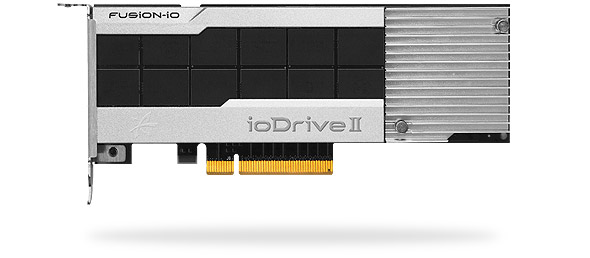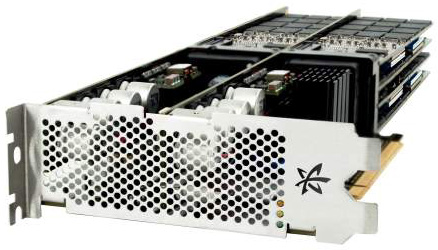The Impact of Disruptive Technologies on the Professional Storage Market
by Johan De Gelas on August 5, 2013 9:00 AM EST- Posted in
- IT Computing
- SSDs
- Enterprise
- Enterprise SSDs
Fusion-IO: the Pioneer
Fusion-IO is telling everyone that wants to listen that it is much more than the vendor of extremely fast PCIe flash cards. Despite the fact that it sells quite a few cards to the storage giants like NetApp, Fusion-IO wants nothing less than to completely change and conquer the storage market.
Fusion-IO's first succesful move was to sell extremely fast ioDrives to the people who live from scale-out applications like Facebook and Apple. These companies ditched their traditional SAN environments very quickly as replacing centralized shared storage by a model where hundreds of servers have a local PCIe flash storage system gave them up to ten times more storage performance at a fraction of the cost of a high-end SAN system.
Ditching your centralized storage is not for everyone of course: your application has to handle replication and thus be able to survive the loss of many server nodes. But as we all know, that is exactly what Google, Facebook, and other scale-out companies did: build applications that replicate data between nodes so that nobody has to worry about a few failing nodes.

The Iodrive: up to 3TB, hundreds of thousands of IOPS
Although scale-out customers were extremely important to Fusion-IO, the company also went also after the virtualization market where centralized storage is king. The ioTurbine is a Hypervisor plug-in that enables server side caching on a virtualized host with a Fusion-IO flash card. The beauty is that ioTurbine does not disable the typical goodies that centralized storage offers in a virtualized environment such as vMotion and High Availability. ioTurbine works with ESXi, Windows 2012/2008 and RHEL.
Fusion-IO ION Data Accelerator is the next generation SAN: PCIe Flash cards inside any decent x86 server, like the Supermicro 6037 or the HP DL380p. ION is typically used for high-end database clusters. Fusion-IO promises that this shared storage can deliver no less than 1 million IOPs.
With the acquisition of NexGen Storage, Fusion-IO is also targeting the midrange market by offering a “flashpool” kind of product. The key difference is that NexGen Storage can use write-back caching, while most vendors do no or limited writing on the flash disks. The Fusion-IO software is also able to provision a certain amount of IOPs for each LUN.
.jpg)
But more than anything else, the Fusion-IO products are offering extreme speeds. Even a one array NexGen N5 series targeted at SMBs promise 100K-300K IOPs, more than any of the much more expensive midrange SANs can offer right now.

The fastest product, the 10TB ioDrive octal, costs around $100k and delivers 1 million IOPs. Even if those numbers are inflated, it is roughly an order of magnitude faster and cheaper (per GB) than the NetApp “Flash Cache”.










60 Comments
View All Comments
pjkenned - Tuesday, August 6, 2013 - link
Hi Johan, one thing to be clear about is that the dollars you are quoting in this article are off by a huge margin. Enterprise storage is one of the most highly discounted areas of technology. Happy to chat more on this subject. Patrick @STHname99 - Tuesday, August 6, 2013 - link
Ahh, the never-ending whine of the Enterprise sale man, who desperately wants to have it both ways --- to be able to charge a fortune and simultaneously to claim that he's not charging a fortune. Good luck with that --- there is, after all, a sucker born every minute.But let's get one thing straight here. If your organization refuses to publish the actual prices at which it sells, then you STFU when people report the prices that ARE published, not the magic secret prices that you claim exist but neither you nor anyone else are ever allowed to actually mention them. You don't get to have it both ways.
AnandTech and similar blogs are not in the business of sustaining your obsolete business model and its never-ending lies about price...
enealDC - Tuesday, August 6, 2013 - link
Thank you!!! lolJohanAnandtech - Tuesday, August 6, 2013 - link
You can not blame a company to do whatever they can to protect their business model, but your comment is on target. The list versus street price models reminds of techniques of salesman on the street in touristic areas: they charge 3 times too much, and you end up with a 50% discount. The end result is that you are still ripped off unless you have intimate knowledge.nafhan - Tuesday, August 6, 2013 - link
My experience with stuff like this is that the low prices are geared towards locking you into their products and getting themselves in the door. As soon as these companies feel certain that changing to a different storage tech would be prohibitively expensive for you, the contract renewal price will go through the roof.In other words, that initial price may actually be very good and very competitive. Just don't expect to get the same deal when things come up for contract renewal.
equals42 - Saturday, August 17, 2013 - link
You shouldn't be making enterprise purchasing decisions unless you have intimate knowledge and have done the necessary research.pjkenned - Tuesday, August 6, 2013 - link
So three perspectives:First - I have been advocating open storage projects for years. I do think we are moving to 90%+ of the market being 4TB drives and SSDs and SDS is a clear step in this direction. I don't sell storage but have been using open platforms for years precisely because of the value I can extract through the effort of sizing the underlying hardware.
Second - Most of the big vendors are public companies. It isn't hard to look at gross margin and figure out ballpark what average discounts are. Most organizations purchasing this type of storage have other needs. The market could push for lower margins so my sense is that the companies buying this class of storage are not just paying for raw storage.
Third - vendors are moving the direction of lower discounts at the low end. Published list prices there are much closer to actual as the discounting trend in the industry is towards lower list prices.
Not to say that pricing is just or logical, but then again, it is a large industry that is poised for a disruptive change. One key thing here is that I believe you can get pricing if you just get a quote. This is the same as other enterprise segments such as the ERP market.
equals42 - Saturday, August 17, 2013 - link
I'll not ask you to STFU as you eloquently abbreviated it. Though in general I believe people ultimately charge what they believe the market will pay.Yes, list prices are generously overpriced in the IT industry. But to ask EMC or IBM to tell you how much they really charge for things is stupid. That's a negotiated rate between them and their customer. BofA or WalMart isn't going to disclose how much they pay for services. Their low negotiated price helps drive efficiencies to better compete with rivals. Heck, ask Kelloggs how much Target pays per box for cereal vs WalMart. No way in hell they're going to tell you. You think a SMB is going to get the same price as Savvis or Bank of America? They can ask for it but good luck. I sense some naiveté in your response.
In essence you're complaining about how inflated the list is vs what the average customer pays. That's a game played out based on supply and demand, market expectations and the blended costs of delivering products.
prime2515103 - Tuesday, August 6, 2013 - link
"Note that the study does not mention the percentage customer stuck in denial :-)."I don't mean to be a jerk or anything, but I can't believe I just read that on Anandtech. It's not the grammar either. A smiley? Good grief...
JohanAnandtech - Tuesday, August 6, 2013 - link
I fixed the sentence, but left the smiley in there. My prerogative ;-)